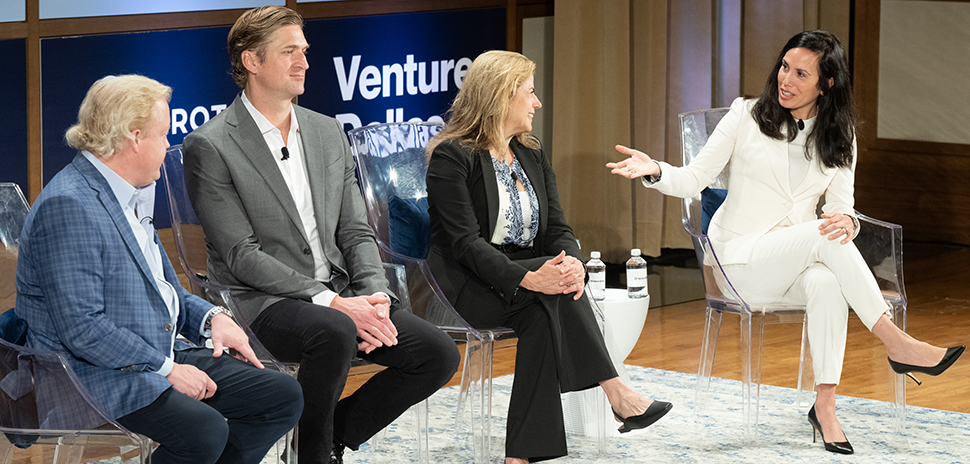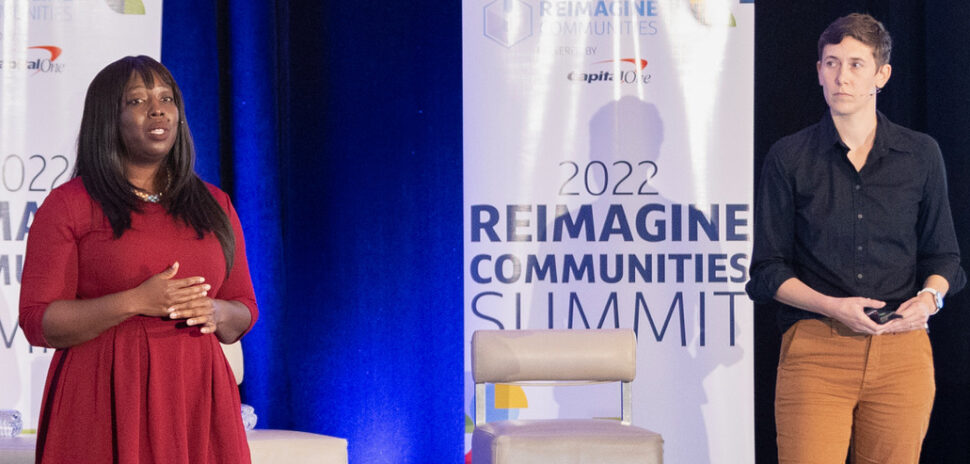The defense-technology industry is in the midst of a transition, opening up new opportunities for innovators and investors alike. Consider that 119 companies in the aerospace and defense sector raised a total of $6.4 billion from venture capitalists in 2021, up from 69 companies and $1.7 billion in 2019, according to data compiled by PitchBook for CNBC.
Experts agreed about the evolving landscape during an Oct. 25 panel discussion of the defense-tech sector, part of the Venture Dallas 2023 conference at Southern Methodist University’s George W. Bush Center. Multiple wars, smarter technologies, and supply-chain pressures are contributing to a paradigm shift that’s making the “military-industrial complex” ripe for disruption, they said.
Titled “Defending Tomorrow: Innovations and Collaborations for Defense Technology,” the panel was moderated by Hal Lambert, the founder of Fort Worth-based investment-management firm Point Bridge Capital and Star Castle Ventures, a six-year-old VC firm focusing on defense-tech companies.
Contributing to the discussion were:
- Sha-Chelle Manning, chief commercial strategist at the U.S. Department of Defense’s Virginia-based Defense Advance Research Projects Agency (DARPA), and a former director of corporate innovation at Irving’s Pioneer Natural Resources Co.
- Dyan Gibbens, strategic advisor for AFWERX, the Nevada-based innovation arm of the U.S. Air Force, and SpaceWERX, the California-based innovation arm of the U.S. Space Force. Gibbens is a graduate of the U.S. Air Force Academy with a B.S. degree in civil engineering.
- Alex Moore, a partner at Austin-based 8VC, a technology and biosciences investment firm that Austin Inno has called the biggest Texas-based VC for startups. Moore was the first employee of Palantir Technologies, a groundbreaking data analytics firm. And 8VC has helped fund Palmer Luckey’s defense contracting firm Anduril Industries, which specializes in autonomous systems like Dive Technologies’ pioneering underwater vehicles.
Moderator Hal Lambert kicked off the discussion with a brief history lesson.
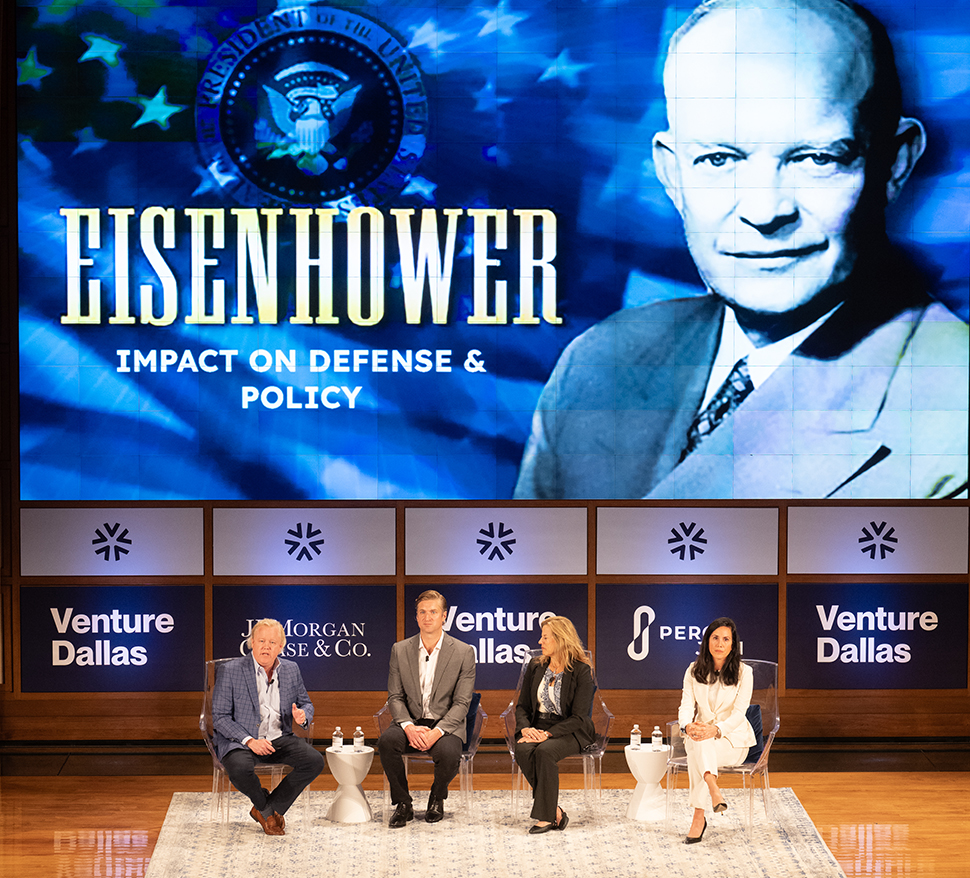
From left: Hal Lambert, Alex Moore, Sha-Chelle Manning, and Dyan Gibbens [Image: Grant Miller Photography/Venture Dallas]
HAL LAMBERT: Basically we’ve got two VCs up here, and two people from the government, and we’re going to talk about how things are working today and how we’re interacting together. But I’d like to start really quickly with a history of our U.S. defense department—where it is, and how it got there.
After World War II, Dwight D. Eisenhower saw there was a huge and growing need to combat communism. And he also saw from World War II that technology and machines were kind of the keys that really turned the tide. That’s what he viewed as the future of warfare, rather than what had historically been the case, where you just put as many people on the battlefield as possible, and the fewer people that died, you won. He realized, no, we’re not going to do that anymore.
So, what did he do? He found the smartest people he could find and, as president, he started funding them. And so that brought us to really through the Cold War. If you look at the initial Cold War founders, we’ve got people that were funded by Eisenhower’s group. And they were responsible for creating some really amazing things: miniaturization, for example, and the fastest-ever manned jet that still today is the fastest-ever manned jet. There were a lot of things accomplished during that period.
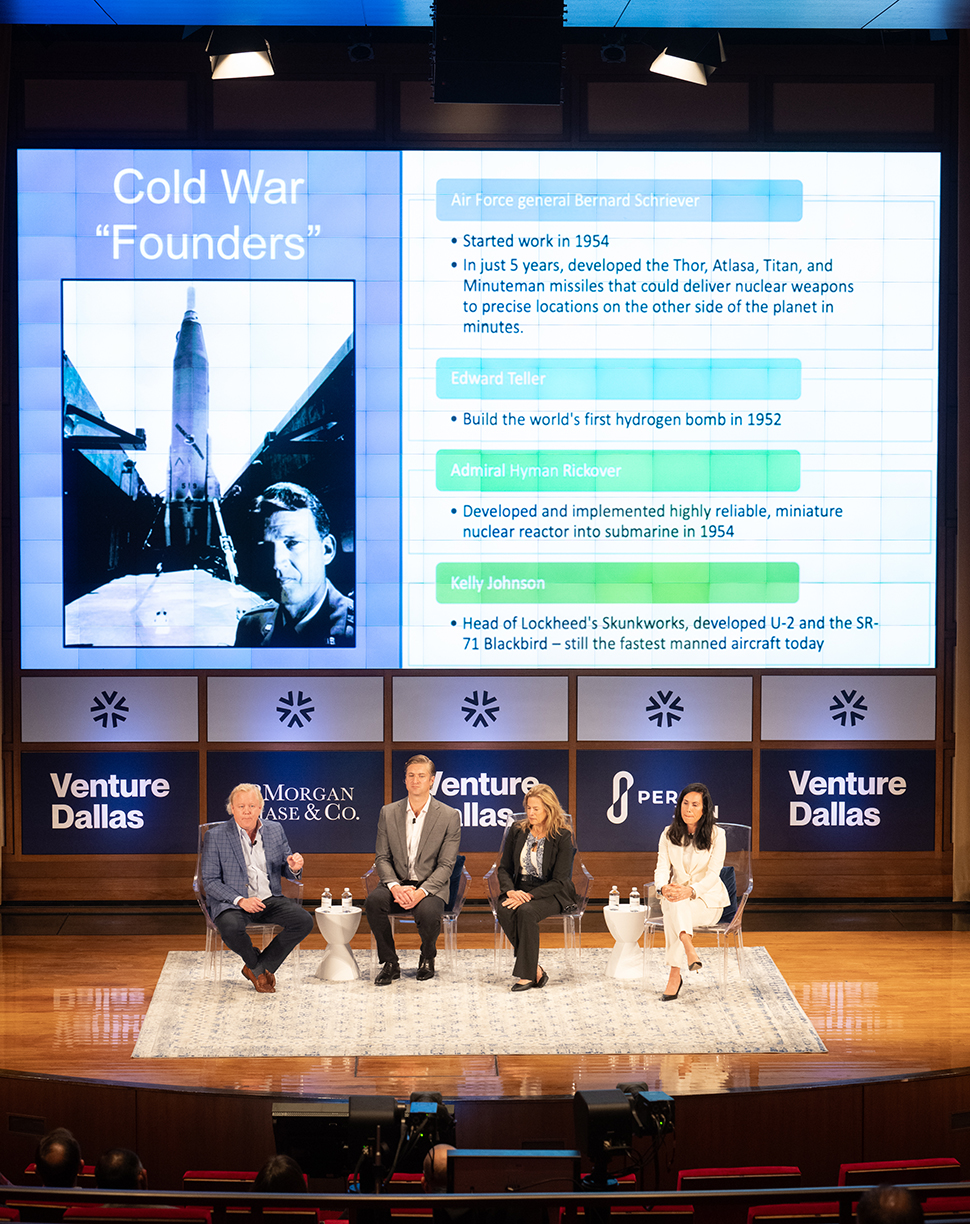
From left: Hal Lambert, Alex Moore, Sha-Chelle Manning, and Dyan Gibbens [Image: Grant Miller Photography/Venture Dallas]
The unfortunate thing is, that went on for about 15 years—and then we moved on to where we are today. And it became all about the procurement process, where the Department of Defense really became what we now think of as the defense-industrial complex—this massive bureaucracy for procurement. And it’s no longer founders doing things—it’s the big prime contractors [called primes]. We managed to win the Cold War because of what we did in the 1950s and ‘60s, but, by the ‘80s, we were at a bureaucracy level. And then after we won the Cold War, they had what was called the “Last Supper” in the ’90s, where they got the big defense groups together and said, ‘Guys, we’re going to cut defense spending massively’—I think it was 16% cuts—’and you guys are going to need to consolidate.’
So, we’re now down to a handful of primes from hundreds of hundreds of companies that were originally primes. Today you have about 80% or 85% of the defense budget going to a handful of primes. And you basically have a bureaucracy within the primes, and a bureaucracy within procurement, so you effectively have a double bureaucracy.
Interestingly, it’s a credit to Palantir, and SpaceX as well, that they sued the DoD in the mid-2015 timeframe. What they said was, ‘Look, you guys are not following the law.’ There was a law passed in the early ’90 that said if there was [an off-the-shelf] commercial product available, the DoD was supposed to be using that product—not go out and give $1 billion to Lockheed to produce that [same] commercial product [from scratch]. They weren’t doing that and so Palantir and SpaceX sued, and they won.
So, starting in 2016, you end up with a whole new ballgame. And that’s really what brought me into this. Now we’ve got commercial products that can be out there and they can work with the DoD. The DoD is interested, and Congress is interested, because they’re upset with a lot with the primes because of delays and the expensiveness of their products.
LAMBERT: What do you think of where we are today? And, are we moving back toward that 1950s model, where you have founders that are tasked with doing specific things and then working through the DoD? Where do you see things headed?
SHA-CHELLE MANNING: I love your talk about Eisenhower. So, DARPA was an agency that was stood up in four months. And the whole idea was: How do we prevent imposed technological surprise? So, when we think about that from a DARPA standpoint, we’re trying to prove that the impossible is possible. And we’re looking long-range, and we’re also looking at disrupting. We funded a little three-person company called Moderna. We financed GPS advancements and, of course, the internet. We’ve done this again and again.
From our standpoint, the question is, how do you bring the best technological scientists to DARPA? And they have to compete there, because they all they get ‘kicked out’ after four years. So, what if you only had four years, and you had access to $4.3 billion every year, and you’re going to go compete with all these other very brilliant scientists? What I found was that it was devastating to them—they’d left universities, they’d left small businesses, they’d left big companies—to not realize that transition to the technologies’ full value. DARPA has been around for 65 years, and now we’re trying to think about how we bring in the best commercial talent, how we commercialize these amazing technologies. We want to make sure we have the tools and the capabilities, and that we look at a plan for transitioning [innovations] to full value.
One other thing I want to mention is Dive Technologies, which had an autonomous submersible [and won a DARPA grant]. Dive was a small startup out of Boston. Maybe 20 years ago, they would have built this exquisite system, but it would have taken them maybe 10 to 12 years to finally get it into the hands of the warfighter. But now, DARPA had an incredible product market development person, we had a great senior commercial advisor, and we got [traction on the submersible] in less than 14 months. That is unheard of. In less than 14 months, Dive went from testing it out to landing a $120 million contract with DoD Australia. So, we know it can be done. How do we do that again and again?
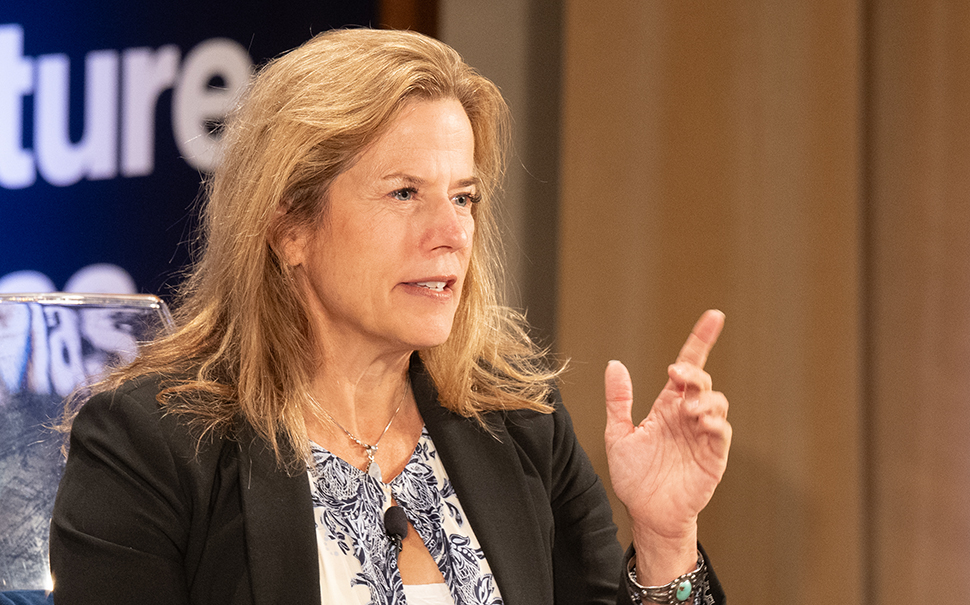
Sha-Chelle Manning [Image: Grant Miller Photography/Venture Dallas]
DYAN GIBBENS: I’ll add a couple things about President Eisenhower and the year 1958. One, you mentioned: DARPA was founded; two, NASA was established; and three, the Small Business Investment Act was established—all in 1958.
Now, 65 years later, there are three things that give me hope about our path forward. One, the DoD’s DIU [Defense Innovation Unit) and their significant increase in funding, pending approval, gives me hope. They’ve been able to leverage OTAs [Other Transaction Authorities]. And you know, the funding and fielding of technology that we do at AFWERX—we’re trying to rapidly fulfill that. DARPA is phenomenal at that. Our CEO’s Rapid Capabilities Office also is phenomenal at that. So those are things that I’m excited about.
ALEX MOORE: I would just add that, one, the defense ecosystem has shifted. In the 1990s or 2000s, it was the primes with the big expensive stuff like Stealth bombers. Now it’s like drones, off-the-shelf stuff dropping grenades on our vehicles, unmanned Shaheds coming into Israel. The type of warfare has changed.
And then, two, we have to have a revolution in the supply chain, and these are massive investing opportunities. Why? Because we have to redo the supply chain. Every single one of these big hardware devices has components from China, and China can just cut those components off, and then our machines don’t work. So, there should be a revolutionary innovative thing that happens here. Not just in these end products that these companies and both of your organizations make, which are really, really important to VCs. But there’s also like a layer lower than that, there’s going to be a revolution in the components and things that go into that.
We have two wars right now happening around ammo, and if we have a third war, there’ll be no ammo— we’re not going to be able to fight any of these wars. So, it’s right to disrupt this paradigm, because the paradigm shifted—it’s already been disrupted by the enemy. And then that provides a lot of opportunity for innovators, for entrepreneurs, for clever investors who care about this stuff. We want to rebuild what the new thing needs to look like. So, it’s actually very exciting in all of those ways.
LAMBERT: That’s why I exclusively started focusing on defense tech in 2017 with my company, Star Castle Ventures. One of the things that’s out there that people talk about is the Valley of Death [the challenges innovators face trying to transition new technologies from the laboratory to the production phase]. But there’s still kind of this conflict of interest at the DoD, where you have military leaders leaving and joining the boards of Lockheed or Boeing.
There was just reporting about the $70 million spent this last year by the primes on lobbying. So obviously they want to protect their interests, their budgets. How does a startup navigate through that and overcome it? I mean, Anduril Industries is getting there; Palantir is there. But Palmer Luckey said, ‘You’ve almost got to be a billionaire to found a defense tech company.’ But, there’s not that many billionaires doing it, so we need to have other people being able to do this. Why don’t we start with you on that, Alex?
MOORE: It upsets and shocks people, but I’ve said that it takes a billion dollars in private capital to IPO a defense company. I think that number actually goes down radically as the DoD evolves. The startups, like those with 10x cheaper products, have to be a little smarter. I think we will organize a lobbying effort to go attack this, but we’re not there yet. The startups will have to be like, killer, and go in there and say, ‘We have a few $100 million on our balance sheets.’ So, one, it’s us building our more sophisticated VC lobbying group to have our voice there. And, two, continual pressure from all sides. The [capital] problem is still rampant, but I think for the optimistic thinkers, it’s like, ‘Well, there’s going to be a big delta when we shift it.’
The real solution is probably something like a big national bill from Congress that the president signs. Something like a Reform the DoD Act, where we go through and free up different pockets of money and add a little more innovation or entrepreneurialism to acquisition officers so they can reallocate money into into things that work and away from things that don’t. Then you can sort of pull away from the primes and give it to the startups a little more.
But organizations like DARPA and AFWERX are on the frontlines of really being intelligent about boosting the most innovative parts of the ecosystem. So, maybe I’m just eternally a mentally ill optimist, but there’s a lot of reasons to be excited with the changes happening.
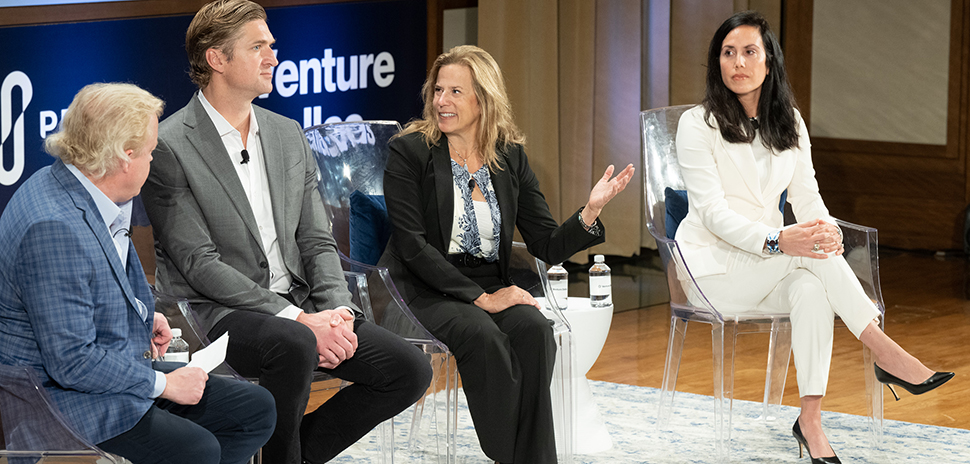
From left: Hal Lambert, Alex Moore, Sha-Chelle Manning, and Dyan Gibbens [Image: Grant Miller Photography/Venture Dallas]
LAMBERT: A lot of it comes down to jobs, and these primes have manufacturing facilities in literally every state. So, they always come in to Congress and say, ‘Hey, you know, you can’t close this program down, because it’s going to cost you jobs in this state.’ But I think as startups create more jobs in the states, they’re going to be able to go back to that as well.
MANNING: We’re sitting here at the Bush Library right now, and it makes you think about back when Texas had a huge oil and gas industry and began thinking about different alternatives—how we were going to think through that to get to having a blended economy.
If we’re thinking about this transition at DARPA, what we’re trying to do is change the internal culture. For example, we wanted to bring in an expert at running a real-time simulation model—someone who’s done that again and again in the commercial space. We needed to get this person—who’s probably created $4 billion or $5 billion in net worth—out in the field. My team had to fight to figure it out, because the person didn’t want to be paid. They’re like, ‘I don’t want to be a consultant, I want to serve! I believe in this.’ So, how do you go champion the best talent with that kind of mindset? It’s not an easy thing to do.
There’s a company called ColdQuanta that’s making position navigation timing. Right now, they’re scaling up 20 of these atomic clocks, which are critical for national defense, for financial trading, for satellites. So we said, ‘What can we do to reduce the barriers?’ We’re trying to take the highest commercial risk, so that commercial can come in with the right investors.
We talked about the Valley of Death, and at DARPA we know we’ve done the work. Our No. 1 goal is zero adversarial capital into those startups. And the only way we can do that is if we have private investors coming in, making investments, and keeping that alignment with that roadmap. We’ve had other investors who’ve said, ‘Well, we don’t get a high enough return for DoD,’ so they’re out. And so, we need people to be up front with us. We’re trying to figure out how do we make that roadmap that enhances the adoption scale commercially. We’re trying to reduce that friction.
GIBBENS: I think we’re all here because we share a vision of a secure and sustainable future. When we look at how we’re investing from an Air Force perspective, the one thing I wanted to highlight is we have an Open Topic solicitation [for technology solutions] that just opened yesterday. Open Topic truly means open—it can be anything.
The Open Topic D2B2 directive—phase two D2B2—is not to be confused with R2-D2! It helps you go past the Phase One directly to Phase Two, which is good for many reasons. Whether you’re in rockets, neuroscience, or electric motors, I recommend you apply to that.
Another thing I’m excited about is the Office of Strategic Capital [to attract and scale private capital] under Dr. Jason Rathje. It was stood up around this time last year by Secretary of Defense Lloyd Austin, and my husband’s the chief investment officer there. They’re doing a lot of really important things. It’s very important for our national security, and we know that national security is economic security.
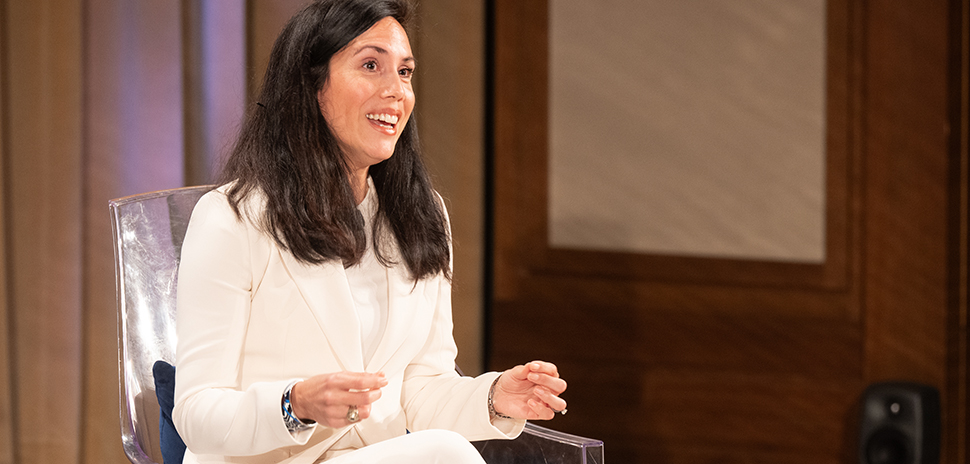
Dyan Gibbens [Image: Grant Miller Photography/Venture Dallas]
LAMBERT: There’s more and more startups coming into the space all the time, and they kind of realize, hey, there’s a lot of government money out there. How does a startup differentiate itself, in your mind—what sets them apart from others? What should we be looking for?
GIBBENS: As far as differentiating, I think it’s as simple as promising and delivering on our promise. Don’t overpromise and underdeliver. Say what you’re going to do and then do it.
Our solicitation process is very short. So, with your team slide deck, clearly articulate the problem and clearly articulate how you’re going to solve it and who you’re solving it for. That’s how you differentiate yourself.
The other thing I’ll say is, there’s certainly a place for marketing, but marketing is not engineering, and marketing is not science. They go together, but there has to be a tangible, viable solution.
MANNING: At DARPA, one thing people don’t realize is, on this program specifically for small businesses, you might say, ‘Well, I don’t really want to go apply for that, because it’s only X amount of money.’ But what that does is, if you’re a startup, it gives you the ability to go through to like a Phase Two, to a Phase Three.
And because you’ve already gone through a competition, you can go straight into a contract. There’s a whole group that helps you kind of tap into that. So, at DARPA, we’ll actually try to grow and say, ‘Hey, we have this great startup, Air Force; let’s go work together. Let’s get them to scale up.’
One thing I’ve heard is a lot of startups are asking for like an acquisition/venture-type group. So something we’re doing is called DARPA Connect. And it’s basically a help desk. So, a startup can call one person and ask, ‘How am I going to navigate this?’ And this is really starting to change the game for the startups.
We also think that startups need to have exits, whether that’s with an acquisition, for example. We’ve had acquisitions with some of the defense products. And reaching out early to the resources that are available has really been key, because of that scale.
MOORE: I would add, there’s a very unique feature on all sides in defense, where there’s a long-term nature to these companies. There’s a unique type of founder who’s not sort of just hacking something together and then jumping around every four years, which is the Silicon Valley ethos.
Is this guy going to work on this when he’s 25—is he going to work on it when he’s 55? I want someone who’s going to, because it’s their whole life and they don’t have anything else. All their ideas are going into this. It should be like a Bell Labs, something that invents and innovates. As it goes along, they can attack different product lines, put pressure on the price, put pressure on each other, yada, yada—take some of the DARPA ideas, run with them.
It’s more about like you’re building this thing that becomes a bigger thing over decades. On the VC side, where we’re selecting the companies and curating the capital, we want that. So, it’s actually a place for family offices. People who understand how to hold things are better investors for defense companies.
It might take a while, yeah. But we venture funds keep extending our horizons for the defense companies–we’ll hold them forever. As an investor, it’s like, ‘Can I find these three or four platforms and just put money into them every year for 30 years and do pretty well?’ In a high-interest rate, volatile world, that’s exciting.
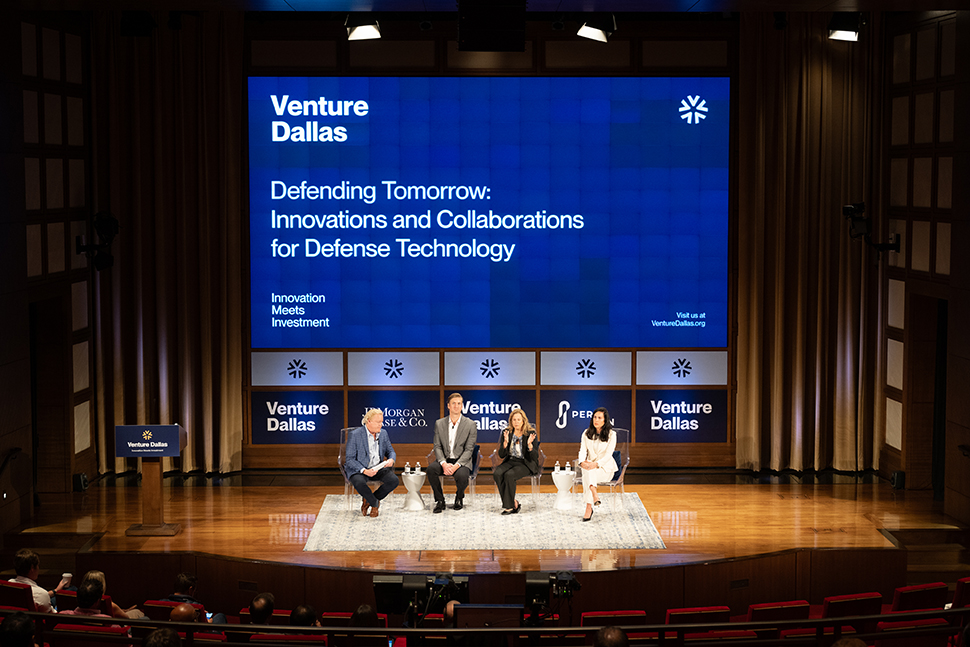
From left: Hal Lambert, Alex Moore, Sha-Chelle Manning, and Dyan Gibbens [Image: Grant Miller Photography/Venture Dallas]
LAMBERT: My last question is: Over the next 10 to 20 years, where do you see the intersection of VC, government, and technology? And, what would you like to see happen—where do you see it heading?
(And, by the way, I want to plug Texas here, because I think Texas is going to be a huge part of this. California people are moving here, and we’ve got a lot of aerospace already here. I think North Texas as well as Austin and Texas as a whole are going to be major players in the space.)
MANNING: My wish is that we can see entrepreneurship as service to the country. I was so fortunate that when I was at Pioneer Natural Resources we turned to DARPA for help with a problem. And Scott Sheffield, Pioneer’s CEO, realized this resulted in a national security benefit while also giving a huge advantage to our company.
So I hope if you’re in this room, and you’re thinking about wanting to invest in a DoD company, that you see that as national service—that you’re bringing your entrepreneurship, your best team, to the game.
GIBBENS: I think that’s wonderful, and we absolutely want to see more of that in Texas.
Another thing I’m excited about is, within AFWERX we have what’s called TACFI and STRATFI. TACFI is a tactical funding increase, and STRATFI is a strategic funding increase. Why am I saying this? Because when you get to STRATFI, it’s a total of $16 million. That’s real money that can impact a startup and help fund them through that Valley. So I want to see more of that.
Also, within Texas, we have been historically very good at funding large capital projects with respect to oil and gas and other areas. As a country, we’re continuing to see aging infrastructure and critical infrastructure, both physical and digital. And I think as a state, we’re very good at funding those and can redirect some of that in that area with an emphasis on defense. And so, I’m betting on America.
Dallas Innovates is a media sponsor of the Venture Dallas 2023 conference held October 25, 2023, at the George W. Presidential Center in Dallas.
![]()
Get on the list.
Dallas Innovates, every day.
Sign up to keep your eye on what’s new and next in Dallas-Fort Worth, every day.

